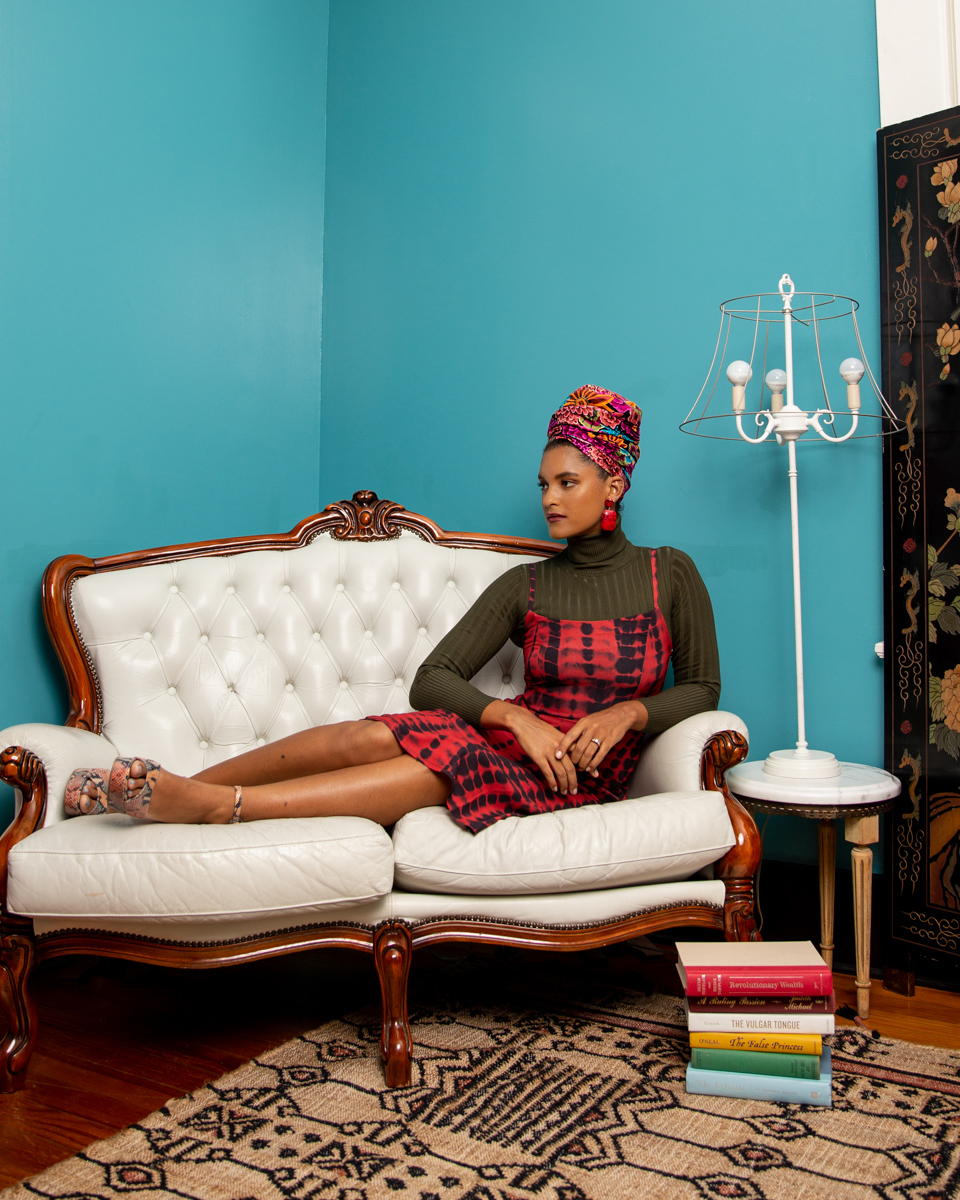When I first began sharing my story at Woke Beauty, I had no idea storytelling could actually change my life. I just knew I had something to say and that my voice could be a vehicle for impact. I’ve never searched for a narrative to ground my brand—my brand is the story, and vice versa. Here’s what brand storytelling means for me.
I created Woke Beauty during a dark, depressive episode in 2017 that conjured up a lot of rumination and existential crises. I had many questions that didn’t serve me: Are the 10 years I’ve spent being a photographer worthless? Why can’t I figure out how to make a living doing what I love? What do I care about? Who am I?
Important questions, but not productive. They fed fear and uncertainty. They buried my experiences, my past, and every valuable lesson I’d ever learned. I had to get real with myself. The ultimate, defining question was:
How do I make this thing that everyone does, mine?
I had an opportunity to use art for good, to facilitate human connection, and, ultimately make people feel better. As I conjured up a dream during that one dark autumn five years ago, I found my calling through my relationship with my mom. My mom, who—despite trauma—has thrived. And who, like many women, doesn’t know just how powerful she is. I can tell her she’s a goddess over and over again but it’s the photographs that show her what I see.
I realized I could use my camera and my words to help women wake up to themselves. I’d take photography and make it conversational and compassionate by sitting down with women, listening to their past stories and future visions, and providing them with inspiration and encouragement. Whether creating content for their brands or images they could reminisce on forever, I’d lead them through the rite of passage they’d always deserved.
As I continue to live out my story, it is no coincidence that my work with resilient women has fostered evolution within me. In turn, the resilience in my mom lives in my work. Through the experience of creating my own brand, I have learned that oftentimes, our creations are a deep reflection of ourselves and our lives.
Storytelling is arguably one of the most crucial aspects of any brand. It contributes to viability, allure, and evolution. Moreover, in our digitized world, it facilitates human connection. It makes audiences feel something. No matter who you are or where you come from, you have a powerful story begging to be told. I hope, through this piece, you are compelled to reveal it.

What is brand storytelling?
The definition of brand storytelling is… well… the story of your brand. It entails everything from the birth of the business to the reason it exists and its vision for the future. Different from the literal story of your brand, brand storytelling encapsulates brand elements and characteristics in a succinct, lively, and dynamic fashion through storytelling strategies such as media platforms, documentation, writing techniques, and public presentations. Brand storytelling serves to bring your brand to life. It is meant to engage and captivate your audience so that they are motivated to dive deeper.
I once heard that if your “why” is big enough, your “how” will find a way. 20% of success is strategy. 80% is psychology or the reason behind what you do.
Why is a personal brand story important?
In our modern digital landscape, compelling content requires getting vulnerable. Consumers, followers, and fans want a peek behind the curtain. They crave tangible narratives and relatability. They want to know, feel, and see you. Successful brand storytelling is personal and requires thoughtfulness. It’s important to maintain continuity and clarity within your narrative in order to reach your audience on a deeper level.
The key is to translate your vision into words and images that will resonate. Not only does your story aid in marketing and sales, but it also sets you apart. It gives you and your brand purpose.
The pain point of many people is that they think their industry is saturated. They will say: “I have no chance.” “What I want to do or what I already do isn’t special or unique.” I challenge you to reconsider those thoughts.
We are all like blades of grass. From afar, we’re not that different. We are breathing, functioning, living humans. But take a step closer, perceive, listen, sympathize and you will see that we all possess unique intricacies. The same way that some blades are taller, some darker, some leaning forward, some are deeply rooted and every single blade is beautifully flawed.

Why is creative writing important?
For me, my writing practice is everything. It’s how I sift through my thoughts in a way that feels meditative and it helps me put words to what’s intangible. I have found many answers and had epiphanies about the world around me (and the world within me) through writing. Let me tell you, I was not the collegiate A+ writer. In fact, I sat in much disappointment with the range of Bs I received. Mediocrity was never really my thing. However, in hindsight, the feedback was almost always: tell us, don’t show us. Ironically, I chose a profession that blends both.
The beauty in creative writing is that it’s your very own. It is basically a reflection of you and your story or your viewpoint on a story or a myriad of stories. Paper holds power. It doesn’t talk back—not really. It sits there holding crystal clear space so that you can pour your mind onto its surface.
In fact, the first phase of building your brand story involves fully comprehending, flushing out, and knowing your story. You’ll need some paper to hold those thoughts.
How do you tell a compelling brand story?
When considering the key aspects of your brand, ask yourself if these five components are present. Is it:
- …meaningful?
- …personal?
- …emotional?
- …simple?
- …authentic?
With that format, you can then journey map your brand storytelling with the following outline.
Phase 1:
One of the biggest issues clients come to me with is: I don’t know who I am or what I have to say. My response is: you do. You just have to get out of your own head. One of the biggest obstacles to telling your story is yourself. The process involves revealing who you are, what you do, what you care about and, why it matters.
Within this phase, define your Brand Heart or Brand Ethos to identify your core tenets and use creative writing to articulate your brand messaging. You might evaluate your purpose, mission, values, and dreams.
Phase 2:
Brain dump. We are not just storming up ideas. We are throwing them on paper until they stick. Within this phase, we work to uncover a multitude of life stories. Prompts to help you get there consist of:
Who are you and how would you describe yourself? What do you want to expose on the front stage? Does your brand fill a niche? Is it surprising or unique? What is important to you?
Consider revealing how your brand solves a problem with a formula such as:
We help you with X by doing Z.
I love using TOMS as an example of a brand with a powerful, concise story:
“While traveling through Argentina in 2006, TOMS founder Blake Mycoskie saw the hardships faced by children without shoes. This inspired him to create a for-profit business with giving at its core. The idea? For every pair of shoes the company sold, a new pair would be given to a child in need.”
Phase 3 + 4:
In these phases, we pull in previously discussed entities such as building your ‘why’ and narrowing in on your ‘who’.
Who do you care about? How do you want to help them? What is your higher purpose? What mission do you want to fulfill?
Phase 5:
This step is based on ‘how’. People crave visibility, integrity, and transparency. This could involve revealing your assembly line, where you produce goods, how you offer services, or the technology you’ve created.
Miranda Bennett Studio is a great example of a brand that reveals its Sustainability Report which you can see here.
Phase Six:
Here, you’ll strive to create excitement and synergy with your potential audience. Sharing your plan of growth will generate more interest and incentive so people invest in your future while making them feel like they’re a part of a higher purpose.
This engaging process begs your time and attention. Be gentle and patient with yourself and remember that words need to breathe, change, and evolve.

Final Words
No matter how much effort you put into this work, you will forever rework, massage, edit, delete, and resurface stories. Your life is your story, one that is being written even at this very moment. As you navigate your brand storytelling, I encourage you to clear the air with these four essential intentions:
Be evergreen. Anyone can create content that is shocking and trend-worthy. Work to create content that will stay with people for days to come.
Build community. Engage, connect, and interact with your audience. Remember, you are not online to sell them, you are online to serve them.
Be profitable so that your storytelling builds value. Followings are cool and ego-boosting but how does your inbox look? Is your content compelling people to engage with you? To purchase your services? To believe in your work?
Last, and perhaps more important than anything I’ve told you today: be human. Say only what you mean. Your story must reflect something that is inherently true about your brand which signifies that it is inherently true about your being.
The internet is a traffic jam. In order to find creative ways to traverse the crowded space, seek human connection.
Brand storytelling is critical to overcoming the masses so you can expose the story that makes you unique, the story that makes you get up in the morning, the story that drives you. It is not just an important aspect of your work, it is the secret to your evolution.






